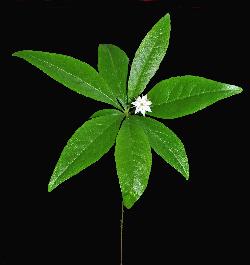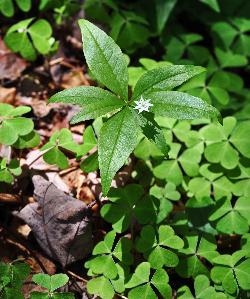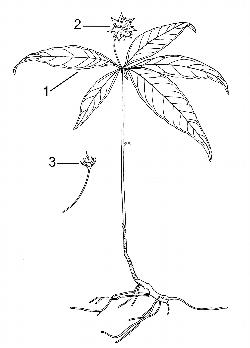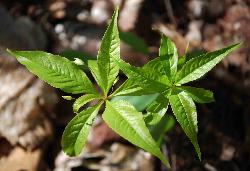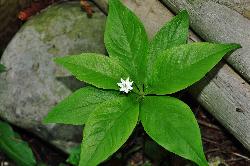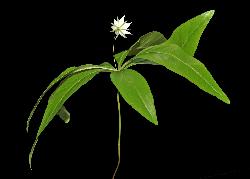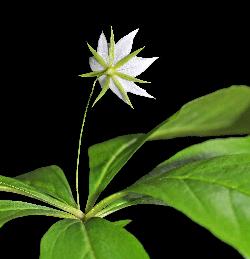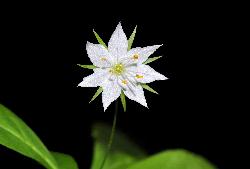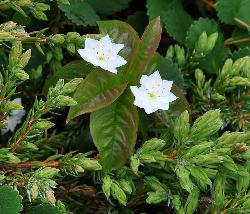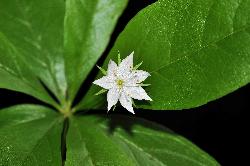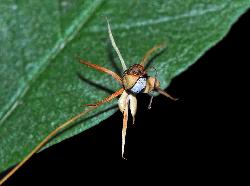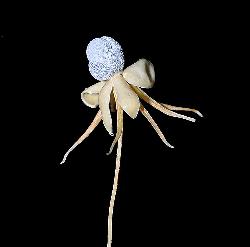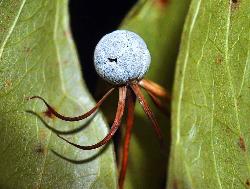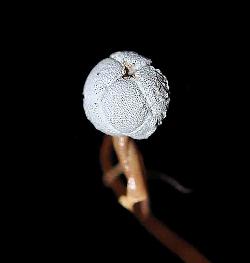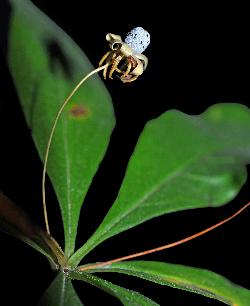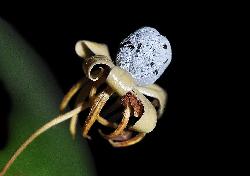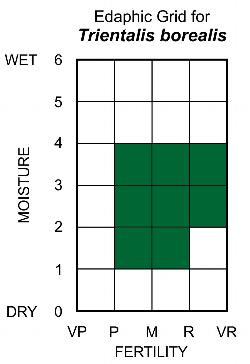Fr: trientale boréale
IA: uapushishkatiapi
Primulaceae - Primrose Family
Note: Numbers provided in square brackets in the text refer to the image presented above; image numbers are displayed to the lower left of each image.
General: An erect perennial forb with attractive star-like white flowers and a terminal whorl of leaves [1–3]. Starflower is a common understorey plant in boreal forest that reproduces primarily asexually, spreading by its slender rhizomes and storing food in the tubers.
The genus Trientalis was moved from the family Primulaceae to the Myrsinaceae a few years ago, but this family is now considered to be a subfamily (Myrsinoideae Burnett) of the Primulaceae (Stevens 2010+). Recent research by Manns and Anderberg (2009) recommended transferring the genus Trientalis, along with Glaux and Anagallis, to the genus Lysimachia.
Key Features: (numbers refer to the illustration [4])
1. Leaves 4–10, in a terminal whorl; blades are lanceolate-elliptic and taper at both ends.
2. Flowers have a flat deeply 7-lobed star-shaped corolla, with overlapping lobes.
3. The fruit is a small light-brown capsule with a few black seeds that have an initial whitish reticulate coating; the capsule is subtended by the persistent calyx lobes.
Stems: Simple, erect, slender, 3–26 cm tall, and unbranched. Aerial stems are annual and develop from the end of small horizontal tubers, 1–2 cm long; the plants spread laterally by slender rhizomes, which develop new tubers at the rhizome tips towards the end of each growing season (Anderson 1970).
Leaves: Simple, pinnately-veined, glabrous, and whorled, with 4–10 leaves of various sizes clustered at the top of the stem [1-2]. When there are several leaves, they are apparently attached in 2 or more contiguous whorls, with the uppermost whorl composed of about 3–5 leaves. Directly below the upper leaves, 1 to several more leaves are attached; no internodes separate these different whorls, and they all appear as a single whorl. Leaf blades are membranaceous, elliptic or elliptic-lanceolate, 2.5–10 cm long, and widest at or below the middle. The width of the blade is quite variable, ranging from 0.6 to 4.5 cm wide [5–6]. The blades taper gradually from the middle to a cuneate or attenuate base and a sharply pointed (acuminate) apex; margins appear entire, but are very shallowly crenate-serrate. On the lower portions of the stem, small alternate scale-like leaves, up to 6 mm long, may occur.
Flowers: Bisexual; 1–3 flowers are borne on slender peduncles, 2–5 cm long, which are shorter than the leaves and arise from the axil of a leaf below the uppermost leaves [7]. Note that floral parts are usually 7, but may vary from 5–9. The calyx has 7 narrow, linear-lanceolate, green lobes that are slightly shorter than and alternate with the corolla lobes [8–9]; the corolla is white, flat, rotate, up to 1 cm across, radially symmetric (actinomorphic), and with 7 elliptic to ovate pointed (acuminate) lobes [10]. The corolla lobes are usually very deeply divided (appearing as separate petals), with their margins overlapping each other in a convolute manner [11–12]. Each corolla lobe has a single vein running the length of the lobe. Flowers have 7 stamens with long filaments that are united at the base in a ring around the ovary; the anthers are oblong and reflex after the pollen is shed. The small globose superior ovary has 5 carpels and bears a single slender style, ending in a small capitate stigma.
Starflower is self-incompatible; thus cross-pollination is essential for fruit and seed set (Barrett and Helenurm 1987). Flowering occurs in early summer; pollination is by insects (entomophily). Different sets of pollinators have been reported from various publications: Anderson and Beare (1983) documented Halictid and Andrenid bees as the primary pollinators of starflower in their Wisconsin research plots, while Barrett and Helenurm (1987) reported that syrphid flies (Carposcalis confusus Curran, C. obscura (Say), and Sphaerophoria bifurcata Knutson) were the primary pollinators in their central New Brunswick plots.
Fruit: A small light brown globose valvate capsule, 1.7–2.7 mm in diameter, is subtended by the narrow calyx lobes, which are more than twice the length of the capsule [13–14]. When the capsule dehisces, the 5 recurved valves of the capsule wall persist below the sphere of 2–14 tightly packed seeds, which together resemble a tiny soccer ball [15–17]. The seeds are rhomboidal, black, and covered with a white to bluish-gray finely reticulate coating that gradually flakes off [18–19]. The seeds, which are dispersed by wind (anemochory), are small, about 0.5–1.5 mm long, and each weigh less than 0.5 mg (Anderson 1971).
Ecology and Habitat: Starflower occurs primarily in forested habitats, but sporadically in bogs and barrens. It appears to grow best under full canopy closure on moist, medium to rich sites where it has high frequency, but rarely exceeds 10–15% cover. It is generally absent on the open and dry woodland sites and the wet forested peatlands and alder swamps.
Edaphic Grid: See image [20]: the Edaphic Grid for Lysimachia borealis (formerly Trientalis borealis).
Forest Types: Starflower occurs with high frequency but low abundance throughout most of the forest types and, therefore, it has little value as an indicator species. However, it is either very sporadic or absent from the following forest types:
Aceretum spicatae (Mountain Maple Thicket Association)
Alnetum rugosae (Alder Swamp Association)
Caricio-Piceetum (Carex-Black Spruce Fen Association)
Kalmio-Piceetum (Kalmia-Conifer Forest Subassociation)
Piceetum marianae (Black Spruce Moss Forest Association)
Sphagno-Piceetum (Sphagnum-Black Spruce Bog Association)
Succession: Within Newfoundland, starflower appears to have a distinct preference for shaded forest habitats. It reproduces primarily vegetatively from below-ground rhizomes and tubers that appear to be regulated by the length of the photoperiod (Anderson and Loucks 1973). The possession of a rhizome system would enhance survival after disturbance, provided there is sufficient shade. However, the roots are concentrated in the humus and would probably not survive intense fire. This may explain its rare occurrence in black spruce forests in our range.
Distribution: Starflower is a north-temperate to boreal species that occurs across Canada; within the Province, it occurs throughout insular Newfoundland and extends as far north as Hebron, 58° 12' N (Scoggan 1979). In the United States, it has a disjunct range; in the east, it extends from Maine west to Minnesota and south along the Appalachians to northern Georgia, while in the western States, it extends from Washington south to California and east to Idaho (USDA, NRCS 2016).
Similar Species Starflower is very distinct and seldom confused with other species. It blooms at the same time as bunchberry (Cornus canadensis L.), but bunchberry has an inflorescence of several small flowers subtended by 4 showy white bracts that are often mistaken for petals.


